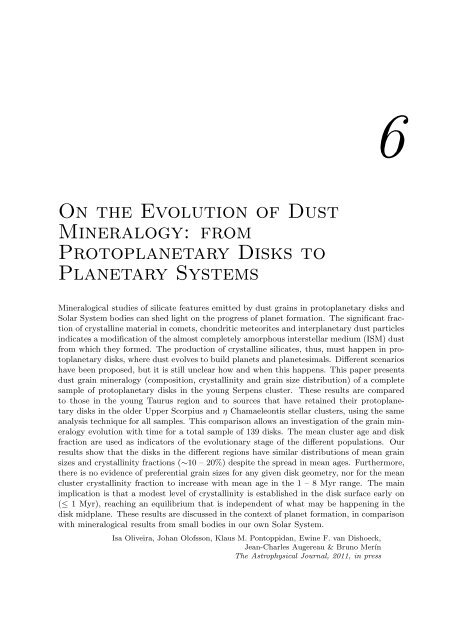Observational Constraints on The Evolution of Dust in ...
Observational Constraints on The Evolution of Dust in ...
Observational Constraints on The Evolution of Dust in ...
You also want an ePaper? Increase the reach of your titles
YUMPU automatically turns print PDFs into web optimized ePapers that Google loves.
6<br />
On the Evoluti<strong>on</strong> <strong>of</strong> <strong>Dust</strong><br />
M<strong>in</strong>eralogy: from<br />
Protoplanetary Disks to<br />
Planetary Systems<br />
M<strong>in</strong>eralogical studies <strong>of</strong> silicate features emitted by dust gra<strong>in</strong>s <strong>in</strong> protoplanetary disks and<br />
Solar System bodies can shed light <strong>on</strong> the progress <strong>of</strong> planet formati<strong>on</strong>. <strong>The</strong> significant fracti<strong>on</strong><br />
<strong>of</strong> crystall<strong>in</strong>e material <strong>in</strong> comets, ch<strong>on</strong>dritic meteorites and <strong>in</strong>terplanetary dust particles<br />
<strong>in</strong>dicates a modificati<strong>on</strong> <strong>of</strong> the almost completely amorphous <strong>in</strong>terstellar medium (ISM) dust<br />
from which they formed. <strong>The</strong> producti<strong>on</strong> <strong>of</strong> crystall<strong>in</strong>e silicates, thus, must happen <strong>in</strong> protoplanetary<br />
disks, where dust evolves to build planets and planetesimals. Different scenarios<br />
have been proposed, but it is still unclear how and when this happens. This paper presents<br />
dust gra<strong>in</strong> m<strong>in</strong>eralogy (compositi<strong>on</strong>, crystall<strong>in</strong>ity and gra<strong>in</strong> size distributi<strong>on</strong>) <strong>of</strong> a complete<br />
sample <strong>of</strong> protoplanetary disks <strong>in</strong> the young Serpens cluster. <strong>The</strong>se results are compared<br />
to those <strong>in</strong> the young Taurus regi<strong>on</strong> and to sources that have reta<strong>in</strong>ed their protoplanetary<br />
disks <strong>in</strong> the older Upper Scorpius and η Chamaele<strong>on</strong>tis stellar clusters, us<strong>in</strong>g the same<br />
analysis technique for all samples. This comparis<strong>on</strong> allows an <strong>in</strong>vestigati<strong>on</strong> <strong>of</strong> the gra<strong>in</strong> m<strong>in</strong>eralogy<br />
evoluti<strong>on</strong> with time for a total sample <strong>of</strong> 139 disks. <strong>The</strong> mean cluster age and disk<br />
fracti<strong>on</strong> are used as <strong>in</strong>dicators <strong>of</strong> the evoluti<strong>on</strong>ary stage <strong>of</strong> the different populati<strong>on</strong>s. Our<br />
results show that the disks <strong>in</strong> the different regi<strong>on</strong>s have similar distributi<strong>on</strong>s <strong>of</strong> mean gra<strong>in</strong><br />
sizes and crystall<strong>in</strong>ity fracti<strong>on</strong>s (∼10 – 20%) despite the spread <strong>in</strong> mean ages. Furthermore,<br />
there is no evidence <strong>of</strong> preferential gra<strong>in</strong> sizes for any given disk geometry, nor for the mean<br />
cluster crystall<strong>in</strong>ity fracti<strong>on</strong> to <strong>in</strong>crease with mean age <strong>in</strong> the 1 – 8 Myr range. <strong>The</strong> ma<strong>in</strong><br />
implicati<strong>on</strong> is that a modest level <strong>of</strong> crystall<strong>in</strong>ity is established <strong>in</strong> the disk surface early <strong>on</strong><br />
(≤ 1 Myr), reach<strong>in</strong>g an equilibrium that is <strong>in</strong>dependent <strong>of</strong> what may be happen<strong>in</strong>g <strong>in</strong> the<br />
disk midplane. <strong>The</strong>se results are discussed <strong>in</strong> the c<strong>on</strong>text <strong>of</strong> planet formati<strong>on</strong>, <strong>in</strong> comparis<strong>on</strong><br />
with m<strong>in</strong>eralogical results from small bodies <strong>in</strong> our own Solar System.<br />
Isa Oliveira, Johan Ol<strong>of</strong>ss<strong>on</strong>, Klaus M. P<strong>on</strong>toppidan, Ew<strong>in</strong>e F. van Dishoeck,<br />
Jean-Charles Augereau & Bruno Merín<br />
<strong>The</strong> Astrophysical Journal, 2011, <strong>in</strong> press
















